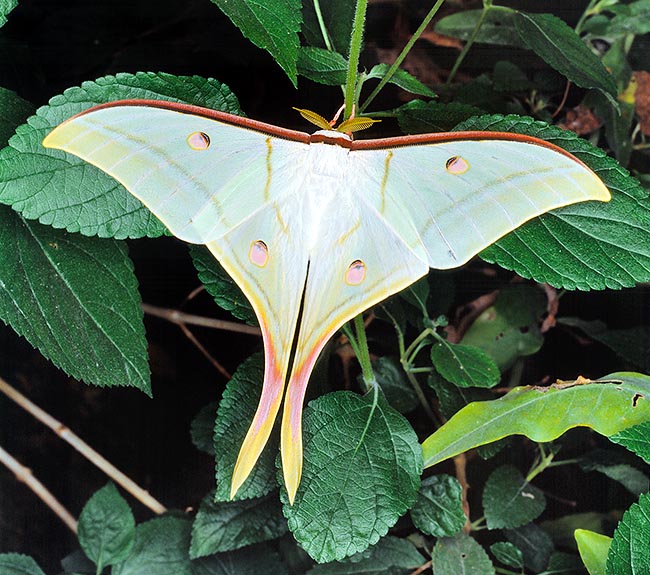Family : Saturniidae

Text © D. Sc. Giuliano Russini – Biologiste Zoologiste

English translation by Mario Beltramini
The Indian Luna moth, called also Indian moon moth (Actias selene Hübner, 1807), is a butterfly afferent to the phylum Arthropods (Arthropoda), class Insects (Insecta), order Lepidopterans (Lepidoptera), family Saturniids (Saturniidae) and genus Actias.
They are mainly animals with nocturnal or crepuscular life; therefore they are part of the group of the Heterocerans (Heterocera), even if, at times, for some subspecies it is possible to sight some masculine specimens flying also by dawn and during the day. The order of the Saturniids family (Saturniidae) is fairly large as it has almost 1900 species. The Actias selene, stays among the most preferred by the breeders of lepidopterans, due to the elegant posture and livery.
Zoogeography
The entomological biologists have found it in most of the Indo Australian and Indochinese geographic areas; therefore it has a fairly vast distribution in the wild.

Actias selene is an Asian night dusk butterfly, Sought for but not endangered © Giuseppe Mazza
More precisely, we find it in the whole Indian subcontinent, in Ceylon, in China and in Indonesia. Some subspecies have been seized also in Borneo, Sumatra, Pakistan, Afghanistan, the Philippines, Russia, Java and Sri Lanka.
Ecology-Habitat
They mainly fly during the night, in the temperate forests, like in China, as well as in the pluvial tropical ones, like in Borneo and Sumatra and also in the humid-mossy like in Java.
Morpho-physiology
The livery has an elegant green-pale bluish colouration, whilst the tails are suffused of pink-yellow. The sexes are morphologically similar, but the males have more robustly pinnate antennae, permanent sexual dimorphism.
The costal fascia of the fore wings is violaceous brown, there are ocellated dots on the hind and fore wings; in the males as well as in the females the body is very hairy and the hind wings have a marginal yellow edge which continues along the tails. The wingspan varies from 8 to 12 cm.
Ethology-Reproductive Biology
The caterpillar is stocky, lively yellowish green, with evident orange or deep yellow warts. It develops on numerous latifolias, arboreal or shrubby, nourishing of the leaves, for instance, of walnut, rhododendron, eucalyptus. The female lays fecundated eggs (on the leaves of these plants), of the size of about 2,5-3 mm, and these are white maculated of black-brown.
The incubation lasts about 11-12 days, after which a first red larval instar (caterpillar) gets out, with spots forming a black saddle, then there will be, in the vital cycle, the passage to a second larval instar, red with black head, finally the third and last instar before the pupation, whose caterpillar is as described at the beginning of this paragraph, yellowish-green, stocky, with evident orange or dark yellow warts. The eggs hatch in spring. The International Union for Conservation of Nature (IUCN) does not identify any danger status for this animal.
→ For general notions about the Lepidoptera please click here.
→ To appreciate the biodiversity within the BUTTERFLIES please click here.
